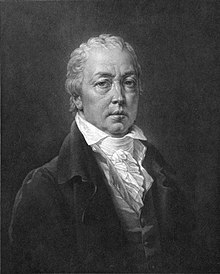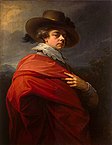You can help expand this article with text translated from the corresponding article in German. (July 2015) Click for important translation instructions.
|
| Heinrich Füger | |
|---|---|
 Mezzotint by Vinzenz Georg Kininger after a self-portrait (c.1818) Mezzotint by Vinzenz Georg Kininger after a self-portrait (c.1818) | |
| Born | Heinrich Füger (1751-12-08)8 December 1751 Heilbronn, Duchy of Württemberg, Holy Roman Empire |
| Died | 5 November 1818(1818-11-05) (aged 66) Vienna, Austrian Empire |
| Occupation | Historical painter |
Heinrich Friedrich Füger (8 December 1751 – 5 November 1818) was a German classicist portrait and historical painter.
Biography
Füger was born in Heilbronn. He became a pupil of Nicolas Guibal in Stuttgart and of Adam Friedrich Oeser in Leipzig. Afterward, he travelled and spent some time in Rome and Naples, where he painted frescoes in the Palazzo Caserta. On his return to Vienna he was appointed court painter, professor, and vice-director of the Academy, and in 1806 director of the Belvedere Gallery.
Among his historical paintings are: The Farewell of Coriolanus (Czernin Gallery, Vienna), Allegory on the Peace of Vienna (1801), The Death of Germanicus (1789), The Assassination of Caesar, and Bathsheba (Budapest Gallery). Among his portraits are those of the Emperor Joseph II, the Grand Duchess Elizabeth Wilhelmine of Württemberg, Wolfgang Amadeus Mozart, Queen Caroline of Naples, and Horatio Nelson, who sat for him in Vienna in 1800 (National Portrait Gallery, London). He painted in the classic style of Louis David and Anton Raphael Mengs and was inclined to be theatrical.
Füger was also a teacher; among his pupils was Gustav Philipp Zwinger, and Franciszek Ksawery Lampi. He died in Vienna.
Selected paintings
-
 Execution of a Vestal Virgin, Detail
Execution of a Vestal Virgin, Detail
-
 Portrait of Prince Nikolay Yusupov, Detail
Portrait of Prince Nikolay Yusupov, Detail
-
 Prometheus Brings Fire to Mankind
Prometheus Brings Fire to Mankind
-
 Apotheosis of Archduke Charles, Duke of Teschen
Apotheosis of Archduke Charles, Duke of Teschen
-
 Portrait of Marie Thérèse of France
Portrait of Marie Thérèse of France
See also
References
- Šárka Leubnerová (ed.), Umění 19. století / Art of the 19th century, p. 14, National Gallery Prague, 2016, ISBN 978-80-7035-598-5
- ^ Gilman, D. C.; Peck, H. T.; Colby, F. M., eds. (1906). "Füger, Heinrich" . New International Encyclopedia (1st ed.). New York: Dodd, Mead.
- "Horatio Nelson". National Portrait Gallery.
- "Franciszek Ksawery Lampi". Retrieved 29 October 2012.
External links
![]() Media related to Heinrich Friedrich Füger at Wikimedia Commons
Media related to Heinrich Friedrich Füger at Wikimedia Commons
- Attribution:
This article incorporates text from a publication now in the public domain: Gilman, D. C.; Peck, H. T.; Colby, F. M., eds. (1905). "Füger, Heinrich" . New International Encyclopedia (1st ed.). New York: Dodd, Mead.
This article about a German painter is a stub. You can help Misplaced Pages by expanding it. |